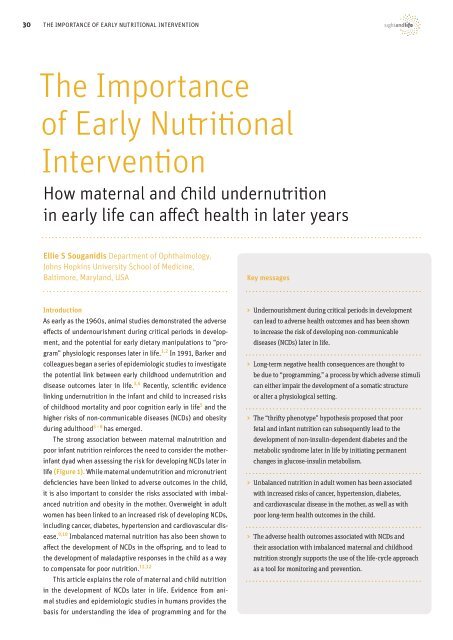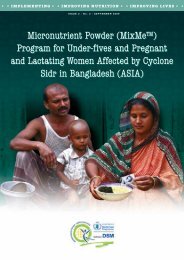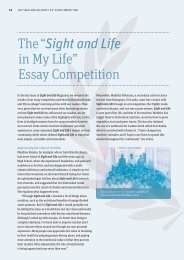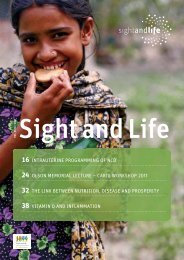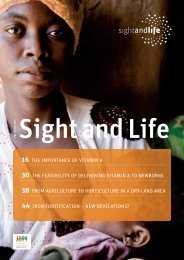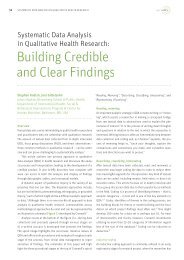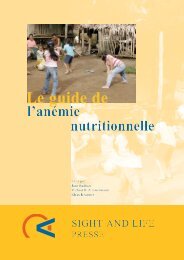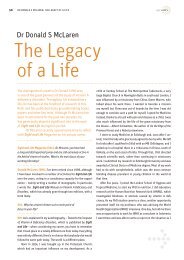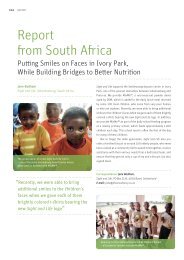The Importance of Early Nutritional Intervention - Sight and Life
The Importance of Early Nutritional Intervention - Sight and Life
The Importance of Early Nutritional Intervention - Sight and Life
Create successful ePaper yourself
Turn your PDF publications into a flip-book with our unique Google optimized e-Paper software.
30 <strong>The</strong> <strong>Importance</strong> <strong>of</strong> <strong>Early</strong> <strong>Nutritional</strong> <strong>Intervention</strong><br />
<strong>The</strong> <strong>Importance</strong><br />
<strong>of</strong> <strong>Early</strong> <strong>Nutritional</strong><br />
<strong>Intervention</strong><br />
How maternal <strong>and</strong> child undernutrition<br />
in early life can affect health in later years<br />
Ellie S Souganidis Department <strong>of</strong> Ophthalmology,<br />
Johns Hopkins University School <strong>of</strong> Medicine,<br />
Baltimore, Maryl<strong>and</strong>, USA<br />
Key messages<br />
Introduction<br />
As early as the 1960s, animal studies demonstrated the adverse<br />
effects <strong>of</strong> undernourishment during critical periods in development,<br />
<strong>and</strong> the potential for early dietary manipulations to “program”<br />
physiologic responses later in life. 1,2 In 1991, Barker <strong>and</strong><br />
colleagues began a series <strong>of</strong> epidemiologic studies to investigate<br />
the potential link between early childhood undernutrition <strong>and</strong><br />
disease outcomes later in life. 3,4 Recently, scientific evidence<br />
linking undernutrition in the infant <strong>and</strong> child to increased risks<br />
<strong>of</strong> childhood mortality <strong>and</strong> poor cognition early in life 5 <strong>and</strong> the<br />
higher risks <strong>of</strong> non-communicable diseases (NCDs) <strong>and</strong> obesity<br />
during adulthood 5 – 8 has emerged.<br />
<strong>The</strong> strong association between maternal malnutrition <strong>and</strong><br />
poor infant nutrition reinforces the need to consider the motherinfant<br />
dyad when assessing the risk for developing NCDs later in<br />
life (Figure 1). While maternal undernutrition <strong>and</strong> micronutrient<br />
deficiencies have been linked to adverse outcomes in the child,<br />
it is also important to consider the risks associated with imbalanced<br />
nutrition <strong>and</strong> obesity in the mother. Overweight in adult<br />
women has been linked to an increased risk <strong>of</strong> developing NCDs,<br />
including cancer, diabetes, hypertension <strong>and</strong> cardiovascular disease.<br />
9,10 Imbalanced maternal nutrition has also been shown to<br />
affect the development <strong>of</strong> NCDs in the <strong>of</strong>fspring, <strong>and</strong> to lead to<br />
the development <strong>of</strong> maladaptive responses in the child as a way<br />
to compensate for poor nutrition. 11,12<br />
This article explains the role <strong>of</strong> maternal <strong>and</strong> child nutrition<br />
in the development <strong>of</strong> NCDs later in life. Evidence from animal<br />
studies <strong>and</strong> epidemiologic studies in humans provides the<br />
basis for underst<strong>and</strong>ing the idea <strong>of</strong> programming <strong>and</strong> for the<br />
> Undernourishment during critical periods in development<br />
can lead to adverse health outcomes <strong>and</strong> has been shown<br />
to increase the risk <strong>of</strong> developing non-communicable<br />
diseases (NCDs) later in life.<br />
> Long-term negative health consequences are thought to<br />
be due to “programming,” a process by which adverse stimuli<br />
can either impair the development <strong>of</strong> a somatic structure<br />
or alter a physiological setting.<br />
> <strong>The</strong> “thrifty phenotype” hypothesis proposed that poor<br />
fetal <strong>and</strong> infant nutrition can subsequently lead to the<br />
development <strong>of</strong> non-insulin-dependent diabetes <strong>and</strong> the<br />
metabolic syndrome later in life by initiating permanent<br />
changes in glucose-insulin metabolism.<br />
> Unbalanced nutrition in adult women has been associated<br />
with increased risks <strong>of</strong> cancer, hypertension, diabetes,<br />
<strong>and</strong> cardiovascular disease in the mother, as well as with<br />
poor long-term health outcomes in the child.<br />
> <strong>The</strong> adverse health outcomes associated with NCDs <strong>and</strong><br />
their association with imbalanced maternal <strong>and</strong> childhood<br />
nutrition strongly supports the use <strong>of</strong> the life-cycle approach<br />
as a tool for monitoring <strong>and</strong> prevention.
sIGHT AND LIFE | Vol. 25 (3) | 2011<br />
31<br />
“<strong>The</strong> strong association<br />
between maternal malnutrition<br />
<strong>and</strong> poor infant nutrition<br />
reinforces the need to consider<br />
the mother-infant dyad.”<br />
An excellent example <strong>of</strong> the effects <strong>of</strong> stunting taken in South Africa.<br />
<strong>The</strong> girl on the left, who suffers from this condition, is aged seven, as is the girl on the right.
32 <strong>The</strong> <strong>Importance</strong> <strong>of</strong> <strong>Early</strong> <strong>Nutritional</strong> <strong>Intervention</strong><br />
figure 1: Consequences <strong>of</strong> impaired maternal <strong>and</strong><br />
child nutrition as related to poor diet, poverty, <strong>and</strong> disease<br />
Short term<br />
consequences:<br />
Mortality, morbidity,<br />
disability<br />
Inadequate dietary intake<br />
Long term consequences:<br />
Adult size, intellectual ability, economic<br />
productivity, reproductive performance,<br />
metabolic <strong>and</strong> cardiovascular disease<br />
Maternal & Child<br />
Undernutrition<br />
Poverty<br />
Disease<br />
Beyond the “thrifty phenotype” hypothesis<br />
Since the initial proposal <strong>of</strong> the “thrifty phenotype” hypothesis,<br />
numerous studies in diverse populations worldwide have confirmed<br />
the link between poor fetal <strong>and</strong> infant growth <strong>and</strong> the<br />
development <strong>of</strong> NCDs or associated risk factors. 19 While the<br />
strength <strong>of</strong> the association has varied across studies, the development<br />
<strong>of</strong> insulin resistance has been consistent across all<br />
age groups studied. 17 Recent studies have also demonstrated<br />
an increased susceptibility to non-insulin-dependent diabetes<br />
in children who caught up in weight <strong>and</strong> body mass index following<br />
undernutrition in early life. 20 <strong>The</strong>se results are particularly<br />
significant for countries undergoing a transition from more traditional<br />
lifestyles to urbanization, <strong>and</strong> populations shifting from a<br />
high prevalence <strong>of</strong> infectious disease morbidity to an increased<br />
prevalence <strong>of</strong> diseases such as diabetes, cardiovascular disease<br />
<strong>and</strong> cancer. 21<br />
<strong>The</strong> ability to program a later susceptibility to non-insulindependent<br />
diabetes has also been investigated in studies asdevelopment<br />
<strong>of</strong> the “thrifty phenotype” hypothesis, respectively.<br />
Using these concepts as a basis for linking imbalanced nutrition<br />
<strong>and</strong> the development <strong>of</strong> NCDs later in life, it reviews the current<br />
scientific evidence on the long-term effects <strong>of</strong> poor maternal <strong>and</strong><br />
child nutrition, <strong>and</strong> reinforces the need for an adequate diet in<br />
both mother <strong>and</strong> child to prevent the subsequent development<br />
<strong>of</strong> NCDs.<br />
<strong>The</strong> “thrifty phenotype” hypothesis<br />
In 1991, Barker <strong>and</strong> colleagues began a series <strong>of</strong> epidemiological<br />
studies to investigate the relationship between poor fetal<br />
<strong>and</strong> infant growth <strong>and</strong> the development <strong>of</strong> glucose intolerance, 3<br />
the metabolic syndrome, 4 cardiovascular disease, 13 <strong>and</strong> other<br />
associated risk factors 14 later in life. In the original study, 93<br />
<strong>of</strong> 468 male participants were found to have impaired glucose<br />
tolerance or undiagnosed diabetes, with a higher proportion <strong>of</strong><br />
men with impaired glucose tolerance having lower mean birth<br />
weight <strong>and</strong> lower weight at one year. 3 Increasing weight at one<br />
year was inversely associated with concentrations <strong>of</strong> 32–33 split<br />
proinsulin, an indicator used to demonstrate β-cell dysfunction. 3<br />
<strong>The</strong>se results suggested that permanent changes in glucoseinsulin<br />
metabolism occurred in response to poor nutrition in<br />
early life, <strong>and</strong> led to the development <strong>of</strong> impaired glucose tolerance<br />
<strong>and</strong> non-insulin-dependent diabetes.<br />
Follow-up studies by Barker <strong>and</strong> colleagues further demonstrated<br />
the association between lower birth weight <strong>and</strong> adverse<br />
health outcomes later in life. Increasing birth weight was inversely<br />
associated with the occurrence <strong>of</strong> syndrome X, defined<br />
by the presence <strong>of</strong> non-insulin-dependent diabetes mellitus,<br />
hypertension, <strong>and</strong> hyperlipidemia. 4 Similarly, higher rates <strong>of</strong><br />
coronary heart disease were observed in individuals with a history<br />
<strong>of</strong> low birth weight 15 <strong>and</strong> men who were small at birth due<br />
to a failure to grow were at an increased risk <strong>of</strong> cardiovascular<br />
disease compared to men whose small size at birth was due to<br />
prematurity. 16<br />
<strong>The</strong> conclusions <strong>of</strong> these studies led to the development<br />
<strong>of</strong> the “thrifty phenotype” hypothesis, which proposed that<br />
poor fetal <strong>and</strong> infant nutrition initiate permanent changes in<br />
glucose-insulin metabolism, <strong>and</strong> can subsequently lead to the<br />
development <strong>of</strong> non-insulin-dependent diabetes <strong>and</strong> the metabolic<br />
syndrome later in life. 17 <strong>The</strong> theory suggested that a “fetal<br />
nutritional thrift” occurs in an effort to selectively protect brain<br />
growth in conditions <strong>of</strong> undernutrition, <strong>and</strong> results in a differential<br />
impact on the growth <strong>and</strong> function <strong>of</strong> different organs. 17 <strong>The</strong><br />
co-occurrence <strong>of</strong> undernutrition early in life <strong>and</strong> overnutrition<br />
in childhood <strong>and</strong> adulthood was hypothesized to impair glucose<br />
tolerance, due to increased insulin resistance <strong>and</strong> reduced<br />
capacity to secrete insulin because <strong>of</strong> poor pancreatic β-cell<br />
development (Figure 2), 17 demonstrating the ability <strong>of</strong> postnatal<br />
events to modify the risks associated with low birth weight. 18<br />
“Numerous studies in diverse<br />
populations worldwide have<br />
confirmed the link between poor fetal<br />
<strong>and</strong> infant growth <strong>and</strong> the<br />
development <strong>of</strong> NCDs or associated<br />
risk factors”
sIGHT AND LIFE | Vol. 25 (3) | 2011 <strong>The</strong> <strong>Importance</strong> <strong>of</strong> <strong>Early</strong> <strong>Nutritional</strong> <strong>Intervention</strong> 33<br />
figure 2: <strong>The</strong> proposed mechanism for the<br />
“Thrifty Phenotype” hypothesis<br />
Other organ<br />
malfunction<br />
e.g. liver<br />
(Adapted from Hales 17)<br />
Maternal<br />
malnutrition<br />
Fetal malnutrition<br />
(especially<br />
amino acids)<br />
↓ β-cell mass<br />
or islet function<br />
↓ Fetal growth<br />
Infant malnutrition<br />
↓ Adult β-cell<br />
function<br />
Obesity,<br />
age<br />
Non-insulin<br />
dependent diabetes<br />
Metabolic syndrome<br />
Other maternal<br />
or placental<br />
abnormalities<br />
Other insulin<br />
resistance<br />
Hypertension<br />
sessing prenatal overnutrition. In studies <strong>of</strong> Pima Indians, newborns<br />
weighing less than 2.5 kg or more than 4.5 kg exhibited<br />
an increased prevalence <strong>of</strong> non-insulin-dependent diabetes,<br />
compared to infants who weighed 2.5 to 4.5 kg at birth. 22 <strong>The</strong> U-<br />
shaped association between birth weight <strong>and</strong> the occurrence <strong>of</strong><br />
non-insulin-dependent diabetes reinforced the conclusions from<br />
the Barker studies, <strong>and</strong> provided evidence for a new association<br />
with overnutrition. Although rat studies have demonstrated<br />
fetal insulin resistance, 23 abnormal cholesterol metabolism, 24<br />
<strong>and</strong> raised adult blood pressure 25 in the <strong>of</strong>fspring <strong>of</strong> rats who<br />
were fed high saturated fats during pregnancy, McCance <strong>and</strong><br />
colleagues provided an alternative explanation. <strong>The</strong>y proposed<br />
that the increased risk associated with higher birth weight could<br />
instead be due to the high prevalence <strong>of</strong> non-insulin-dependent<br />
diabetes in the population, <strong>and</strong> could potentially signify a genetic<br />
predisposition to insulin resistance. 22<br />
Finally, recent studies have addressed some <strong>of</strong> the criticisms<br />
<strong>of</strong> Barker <strong>and</strong> colleagues’ original studies, such as their reliance<br />
on birth weight as the primary measure <strong>of</strong> prenatal etiologic<br />
pathways. 26 <strong>The</strong>re has also been an increasing focus on the role<br />
<strong>of</strong> genetic <strong>and</strong> environmental factors in the subsequent development<br />
<strong>of</strong> adult onset NCDs, <strong>and</strong> the effects <strong>of</strong> suboptimal maternal<br />
nutrition, as detailed below.<br />
<strong>The</strong> role <strong>of</strong> imbalanced maternal nutrition<br />
Fetal undernutrition, which occurs when fetal nutrient dem<strong>and</strong><br />
exceeds placental supply, is influenced by a variety <strong>of</strong> factors,<br />
including maternal body composition <strong>and</strong> maternal dietary intake.<br />
27 Adaptations by the fetus to undernutrition, including<br />
altered hormone production, metabolic changes, <strong>and</strong> the redistribution<br />
<strong>of</strong> blood flow, 28 demonstrate the potential role <strong>of</strong> the<br />
mother in fetal programming. 27 Decreased maternal food intake,<br />
for example, can lower the concentrations <strong>of</strong> insulin, insulin-like<br />
growth factor-1 <strong>and</strong> glucose in the fetus, reducing the transfer<br />
<strong>of</strong> amino acids <strong>and</strong> glucose from mother to fetus <strong>and</strong> adversely<br />
affecting fetal growth. 29 Because underweight women have been<br />
shown to have a higher incidence <strong>of</strong> low birth weight infants, 30<br />
it is increasingly more important to monitor the prevalence <strong>of</strong><br />
maternal undernutrition <strong>and</strong> the effects it can have on a child’s<br />
risk <strong>of</strong> developing NCDs.<br />
Maternal short stature, thought to reflect malnutrition early<br />
in life, has been linked to a number <strong>of</strong> adverse outcomes in the<br />
mother-infant dyad, including an increased risk <strong>of</strong> stunting <strong>and</strong><br />
cephalopelvic disproportion in the child. 31,32 Because child<br />
stunting has been associated with an increased risk <strong>of</strong> obesity<br />
<strong>and</strong> chronic diseases later in life, the effects <strong>of</strong> imbalanced nutrition<br />
in both the mother <strong>and</strong> the child may have the capacity<br />
to compound from generation to generation. 32 In 2005, Garrett<br />
<strong>and</strong> Ruel investigated the prevalence <strong>of</strong> stunted child-overweight<br />
mother pairs worldwide, <strong>and</strong> found a higher frequency<br />
<strong>of</strong> this phenomenon in countries undergoing a nutrition transition.<br />
33 <strong>The</strong> authors proposed that, even in the midst <strong>of</strong> economic<br />
development, countries with historically high rates <strong>of</strong> childhood<br />
stunting may continue to experience childhood stunting, whereas<br />
increased household availability <strong>of</strong> food <strong>and</strong> energy may promote<br />
growing rates <strong>of</strong> obesity among stunted mothers. 33<br />
“Maternal overweight can have<br />
significant health consequences for<br />
both the mother <strong>and</strong> the child”
34 <strong>The</strong> <strong>Importance</strong> <strong>of</strong> <strong>Early</strong> <strong>Nutritional</strong> <strong>Intervention</strong><br />
figure 3: <strong>The</strong> use <strong>of</strong> the life-cycle approach in<br />
assessing the consequences <strong>of</strong> imbalanced nutrition in the<br />
mother <strong>and</strong> child<br />
Low birth<br />
weight baby<br />
Child growth<br />
failure<br />
<strong>Early</strong> Pregnancy<br />
Small adult<br />
women<br />
Low weight &<br />
height in teens<br />
Additional associations between low birth weight <strong>and</strong> the subsequent<br />
development <strong>of</strong> diabetes have been investigated with<br />
regard to genetics. <strong>The</strong> <strong>of</strong>fspring <strong>of</strong> diabetic fathers were found<br />
to have a lower birth weight <strong>and</strong> an increased risk <strong>of</strong> later developing<br />
diabetes. 41 Furthermore, low birth weight in the child was<br />
predictive <strong>of</strong> diabetes if paternal diabetes was present; the same<br />
association was not observed for maternal diabetes, which had<br />
previously been associated with increased birth weight. 41 Twin<br />
studies, on the other h<strong>and</strong>, have shown that the increased risk<br />
<strong>of</strong> developing non-insulin-dependent diabetes is independent<br />
<strong>of</strong> genetic constitution. 42 Although genetic polymorphisms may<br />
ultimately play a role in birth weight <strong>and</strong> the resultant changes<br />
in glucose metabolism, 43 the effects are much weaker than those<br />
<strong>of</strong> decreased birth weight. 44<br />
Maternal overweight can have significant health consequences<br />
for both the mother <strong>and</strong> the child. Direct links to cancer, diabetes,<br />
hypertension, <strong>and</strong> cardiovascular disease in women who<br />
are overweight have been well-established. 9,10 Similarly, children<br />
exposed to diabetes or maternal obesity in utero have been<br />
shown to be at increased risk <strong>of</strong> developing non-insulin-dependent<br />
diabetes, 34,35 cardiovascular risk factors, 36 <strong>and</strong> the metabolic<br />
syndrome. 37 As the prevalence <strong>of</strong> overweight <strong>and</strong> obesity<br />
increases, the effects <strong>of</strong> maternal overnutrition are becoming increasingly<br />
more relevant, <strong>and</strong> demonstrate the need to maintain<br />
a balanced diet throughout the life cycle. Fluctuations in either<br />
direction, namely through undernutrition or overnutrition, can<br />
result in adverse health consequences for both mother <strong>and</strong> child.<br />
<strong>The</strong>se findings also reveal the detrimental effects that can occur<br />
if there is a perpetuating cycle <strong>of</strong> obesity, insulin resistance, <strong>and</strong><br />
their associated disease outcomes, without intermittent nutritional<br />
interventions.<br />
<strong>The</strong> role <strong>of</strong> genetics<br />
A genetic link between low birth weight <strong>and</strong> later diabetes was<br />
initially proposed by Hattersley <strong>and</strong> colleagues 38 as an alternative<br />
explanation to the environmental influences described<br />
above. A mutation known to cause maturity onset diabetes <strong>of</strong> the<br />
young (MODY), a syndrome <strong>of</strong> early onset non-insulin-dependent<br />
diabetes with an autosomal dominant inheritance pattern, 39 has<br />
been associated with lower birth weight <strong>and</strong> later diabetes when<br />
present in the fetus. 40 <strong>The</strong> mutation’s low frequency, however,<br />
makes it an unlikely explanation for the associations described<br />
by Barker <strong>and</strong> colleagues. Instead, insulin’s role as a growth<br />
promoter in utero may explain why mutations altering insulin<br />
secretion or resistance could also affect fetal growth <strong>and</strong> the development<br />
<strong>of</strong> diabetes. 38<br />
“<strong>The</strong> adverse health outcomes<br />
asso ciated with NCDs<br />
strongly support the use <strong>of</strong> the<br />
life-cycle approach”<br />
Conclusions<br />
<strong>The</strong> adverse health outcomes associated with NCDs <strong>and</strong> their<br />
link to imbalanced maternal <strong>and</strong> childhood nutrition strongly<br />
support the use <strong>of</strong> the life-cycle approach as a tool for monitoring<br />
<strong>and</strong> prevention (Figure 3). Monitoring should be performed<br />
throughout all decades <strong>of</strong> life, extending from gestation to adult<br />
life, as well as across generations. 45 While insulin resistance<br />
has been used as the prototypical example <strong>of</strong> a “thrifty” characteristic,<br />
more recent evidence has exp<strong>and</strong>ed the time in which<br />
“thrifty”-like characteristics can manifest themselves, ranging<br />
from changes in development to phenotypic changes seen well<br />
after birth. 46 – 49 This further reinforces the need to take on a lifecycle<br />
approach when considering NCDs.<br />
As the co-occurrence <strong>of</strong> undernourishment in the child<br />
<strong>and</strong> overweight in the mother becomes increasingly more prevalent,<br />
33 future policies <strong>and</strong> nutritional interventions must be<br />
developed to combat the adverse effects associated with imbalanced<br />
nutrition during critical periods, <strong>and</strong> the capacity for<br />
postnatal events to modify the risks associated with low birth<br />
weight. Ultimately, the goal <strong>of</strong> reducing the prevalence rates <strong>of</strong><br />
glucose intolerance, non-insulin-dependent diabetes, cardiovascular<br />
disease, <strong>and</strong> the metabolic syndrome is dependent upon<br />
further scientific investigation, <strong>and</strong> the integration <strong>of</strong> knowledge<br />
regarding all associated risk factors <strong>and</strong> subsequent adverse<br />
health outcomes.
sIGHT AND LIFE | Vol. 25 (3) | 2011 <strong>The</strong> <strong>Importance</strong> <strong>of</strong> <strong>Early</strong> <strong>Nutritional</strong> <strong>Intervention</strong> 35<br />
Correspondence: Ellie S Souganidis, Johns Hopkins School<br />
<strong>of</strong> Medicine, 400 N Broadway, M015, Baltimore, MD 21287, USA<br />
E-mail: esougan1@jhmi.edu<br />
References<br />
01. Widdowson EM, McCance RA. <strong>The</strong> effect <strong>of</strong> finite periods <strong>of</strong><br />
undernutrition at different ages on the composition <strong>and</strong><br />
subsequent development <strong>of</strong> the rat. Proc R Soc Lond B Biol Sci<br />
1963;158:329 – 42.<br />
02. Lucas A. Programming by early nutrition in man. In: <strong>The</strong> Childhood<br />
Environment <strong>and</strong> Adult Disease, pp 38 – 55. CIBA Foundation<br />
Symposium 156. Wiley: Chichester, UK, 1991.<br />
03. Hales CN, Barker DJP, Clark PMS et al. Fetal <strong>and</strong> infant growth <strong>and</strong><br />
impaired glucose tolerance at age 64. BMJ 1991;303:1019–22.<br />
04. Barker DJP, Hales CN, Fall CHD et al. Type 2 (non-insulin-dependent)<br />
diabetes mellitus, hypertension <strong>and</strong> hyperlipidaemia<br />
(syndrome X): relation to reduced fetal growth. Diabetologia<br />
1993;36:62–7<br />
05. Victora CG, Adair L, Fall C et al. Maternal <strong>and</strong> Child Undernutrition<br />
Study Group. Maternal <strong>and</strong> Child Undernutrition: Consequences for<br />
Adult Health <strong>and</strong> Human Capital. Lancet 2008;371: 340–57.<br />
06. Sawaya AL, Martins PA, Grillo LP et al. Long-Term Effects <strong>of</strong> <strong>Early</strong><br />
Malnutrition on Body Weight Regulation. Nutr Rev 2004;62:127–33.<br />
07. Sawaya AL, Sesso R, Florencio TM et al. Association between<br />
Chronic Undernutrition <strong>and</strong> Hypertension. Matern Child Nutr<br />
2005;1:155–63.<br />
08. Sawaya AL, Martins PA, Baccin Martins VJ et al. Malnutrition,<br />
Long-Term Health <strong>and</strong> the Effect <strong>of</strong> <strong>Nutritional</strong> Recovery. Nestle<br />
Nutr Workshop Ser Pediatr Program 2009;63:95–105.<br />
09. Prentice AM. <strong>The</strong> Emerging Epidemic <strong>of</strong> Obesity in Developing<br />
Countries. Int J Epidemiol 2006;35:93–9.<br />
10. World Health Organization. Diet, Nutrition <strong>and</strong> the Prevention <strong>of</strong><br />
Chronic Diseases: Report <strong>of</strong> a Joint WHO/FAO Expert Consultation.<br />
Geneva, Switzerl<strong>and</strong>: WHO, 2003.<br />
11. World Health Organization (2008) 2008–2013 Action Plan for the<br />
Global Strategy for the Prevention <strong>and</strong> Control <strong>of</strong> Noncommunicable<br />
Diseases, World Health Organization<br />
12. McMillen IC, Robinson JS. Developmental origins <strong>of</strong> the metabolic<br />
syndrome: prediction, plasticity, <strong>and</strong> programming. Physiol Rev<br />
2005;85:571–633.<br />
13. Barker DJP. Fetal origins <strong>of</strong> coronary heart disease. BMJ<br />
1995;311:171–4.<br />
14. Barker DJP, Meade TW, Fall CHD et al. Relation <strong>of</strong> fetal <strong>and</strong> infant<br />
growth to plasma fibrinogen <strong>and</strong> factor VII concentrations in adult<br />
life. BMJ 1992;304:148–52.<br />
15. Osmond C, Barker DJP, Winter PD et al. <strong>Early</strong> growth <strong>and</strong> death from<br />
cardiovascular disease in women. BMJ 1993;307:1519–24.<br />
16. Barker DJP, Osmond C, Simmonds SJ et al. <strong>The</strong> relation <strong>of</strong> small<br />
head circumference <strong>and</strong> thinness at birth to death from<br />
cardiovascular disease in adult life. BMJ 1993;306:422–6.<br />
17. Hales CN, Barker DJP. <strong>The</strong> thrifty phenotype hypothesis. Br Med<br />
Bull 2001;60:5–20.<br />
18. Barker DJP. Mothers, Babies <strong>and</strong> Disease in Later <strong>Life</strong>. London:<br />
BMJ Publishing Group, 1994.<br />
19. Hales CN, Desai M, Ozanne SE. <strong>The</strong> thrifty phenotype hypothesis:<br />
how does it look after 5 years Diabet Med 1997;14:189–95.<br />
20. Forsén T, Eriksson J, Tuomilehto J et al. <strong>The</strong> fetal <strong>and</strong> childhood<br />
growth <strong>of</strong> persons who develop type 2 diabetes. Ann Intern Med<br />
2000;133:176–82.<br />
21. Fall CHD. Non-industrialised countries <strong>and</strong> affluence. Br Med Bull<br />
2001;60:33–50.<br />
22. McCance DR, Pettitt DJ, Hanson RL et al. Birthweight <strong>and</strong> noninsulin<br />
dependent diabetes: thrifty genotype, thrifty phenotype, or<br />
surviving small baby genotype. BMJ 1994;308:942–5.<br />
23. Guo F, Jen KLC. High fat feeding during pregnancy <strong>and</strong> lactation<br />
affects <strong>of</strong>fspring metabolism in rats. Physiol Behav 1995;57:681–6.<br />
24. Brown SA, Rogers LK, Dunn JK et al. Development <strong>of</strong> cholesterol<br />
homeostatic memory in the rat is influenced by maternal diets.<br />
Metab Clin Exp 1990;39:468–73.<br />
25. Langley-Evans SC. Intrauterine programming <strong>of</strong> hypertension<br />
in the rat: nutrient interactions. Comp Biochem Physiol<br />
1996;114:327–31.<br />
26. Gillman MW. Epidemiological challenges in studying the fetal<br />
origins <strong>of</strong> adult chronic disease. Int J Epidemiol 2002;31:294–9.<br />
27. Barker DJP. <strong>The</strong> malnourished baby <strong>and</strong> infant. Br Med Bull<br />
2001;60:69–88.<br />
28. Fowden AL. Endocrine regulation <strong>of</strong> fetal growth. Reprod Fertil Dev<br />
1995;7:351–63.<br />
29. Oliver MH, Harding JE, Breier BH et al. Glucose but not a mixed<br />
amino acid infusion regulates plasma insulin-like growth factor-1<br />
concentrations in fetal sheep. Pediatr Res 1993;34:62–5.<br />
30. Edwards LE, Alton IR, Barrada MI et al. Pregnancy in the underweight<br />
woman. Course, outcome, <strong>and</strong> growth patterns <strong>of</strong> the infant.<br />
Am J Obstet Gynecol 1979;135:297–302.<br />
31. Sichieri R, Silva CV, Moura AS. Combined effect <strong>of</strong> short stature<br />
<strong>and</strong> socioeconomic status on body mass index <strong>and</strong> weight gain<br />
during reproductive age in Brazilian women. Braz J Med Biol Res<br />
2003;36:1319–25.<br />
32. Ferreira HS, Moura FA, Cabral CR Jr et al. Short stature <strong>of</strong> mothers<br />
from an area endemic for undernutrition is associated with<br />
obesity, hypertension <strong>and</strong> stunted children: a population-based<br />
study in the semi-arid region <strong>of</strong> Alagoas, Northeast Brazil. Br J Nutr<br />
⇢<br />
2009;101:1239–45.
36 <strong>The</strong> <strong>Importance</strong> <strong>of</strong> <strong>Early</strong> <strong>Nutritional</strong> <strong>Intervention</strong><br />
33. Garrett JL, Ruel MT. Stunted Child-Overweight Mother Pairs:<br />
Prevalence <strong>and</strong> Association with Economic Development <strong>and</strong><br />
Urbanization. Food Nutr Bull 2005;26:209–21.<br />
34. Dabelea D, Hanson R, Bennett P et al. Increasing prevalence<br />
<strong>of</strong> type II diabetes in American Indian children. Diabetologia<br />
1998;41:904–10.<br />
35. Dabelea D, Hanson R, Lindsay R et al. Intrauterine exposure to<br />
diabetes conveys risk for type 2 diabetes <strong>and</strong> obesity: a study <strong>of</strong><br />
discordant sibships. Diabetes 2000;49:2208–11.<br />
36. Charles M, Pettitt D, Hanson R et al. Familial <strong>and</strong> metabolic factors<br />
related to blood pressure in Pima Indian children. Am J Epidemiol<br />
1994;140:123–31.<br />
37. Boney CM, Verma A, Tucker R et al. Metabolic syndrome in<br />
childhood: association with birth weight, maternal obesity, <strong>and</strong><br />
gestational diabetes mellitus. Pediatrics 2005;115:e290–6.<br />
38. Hattersley AT, Tooke JE. <strong>The</strong> fetal insulin hypothesis: an alternative<br />
explanation <strong>of</strong> the association <strong>of</strong> low birthweight with diabetes <strong>and</strong><br />
vascular disease. Lancet 1999;353:1789–92.<br />
39. Fajans SS, Floyd JC, Tattersall RB et al. <strong>The</strong> various faces<br />
<strong>of</strong> diabetes in the young: changing concepts. Arch Intern<br />
Med 1976;136:194–202.<br />
40. Hattersley AT, Beards F, Ballantyne E et al. Mutations in the<br />
glucokinase gene <strong>of</strong> the fetus result in reduced birth weight.<br />
Nat Genet 1998;19:268–70.<br />
41. Lindsay RS, Dabelea D, Roumain J et al. Type 2 diabetes <strong>and</strong> low<br />
birth weight: the role <strong>of</strong> paternal inheritance in the association <strong>of</strong><br />
low birth weight <strong>and</strong> diabetes. Diabetes 2000;49:445–9.<br />
42. Poulsen P, Vaag AA, Kyvik KO et al. Low birth weight is associated<br />
with NIDDM in discordant monozygotic <strong>and</strong> dizygotic twin pairs.<br />
Diabetologia 1997;40:439–46.<br />
43. Dunger DB, Ong KK, Huxtable SJ et al. Association <strong>of</strong> the INS VNTR<br />
with size at birth. ALSPAC Study Team Avon longitudinal study <strong>of</strong><br />
pregnancy <strong>and</strong> childhood. Nat Genet 1998;19:98–100.<br />
44. Ong KK, Phillips DI, Fall C et al. <strong>The</strong> insulin gene VNTR, type 2<br />
diabetes <strong>and</strong> birth weight. Nat Genet 1999;21:262–3.<br />
45. Kuh DL, Ben-Shlomo Y. A <strong>Life</strong> Course Approach to Chronic Disease<br />
Epidemiology: Tracing the Origins <strong>of</strong> Ill-health from <strong>Early</strong> to Adult<br />
<strong>Life</strong>. Oxford: Oxford University Press, 1997.<br />
46. Gluckman PD, Hanson MA. Living with the past: evolution,<br />
development, <strong>and</strong> patterns <strong>of</strong> disease. Science 2004;305:1733–6<br />
47. Gluckman PD, Hanson MA, Spencer HG et al. Environmental influences<br />
during development <strong>and</strong> their later consequences for health<br />
<strong>and</strong> disease: implications for the interpretation <strong>of</strong> empirical studies.<br />
Proc Biol Sci 2005;272:671–7.<br />
48. Bateson P, Barker D, Clutton-Brock T et al. Developmental plasticity<br />
<strong>and</strong> human health. Nature 2004;430:419–21.<br />
49. Uller T. Developmental plasticity <strong>and</strong> the evolution <strong>of</strong> parental<br />
effects. Trends Ecol Evol 2008;23:432–8.<br />
Order now !<br />
DSM’s new color poster<br />
“A Practical Guide to Vitamins<br />
in Nutrition” examines the<br />
full range <strong>of</strong> fat- <strong>and</strong> water-soluble<br />
vitamins, their roles <strong>and</strong><br />
main sources. You can order<br />
copies <strong>of</strong> this poster by emailing<br />
celia.gies@dsm.com


